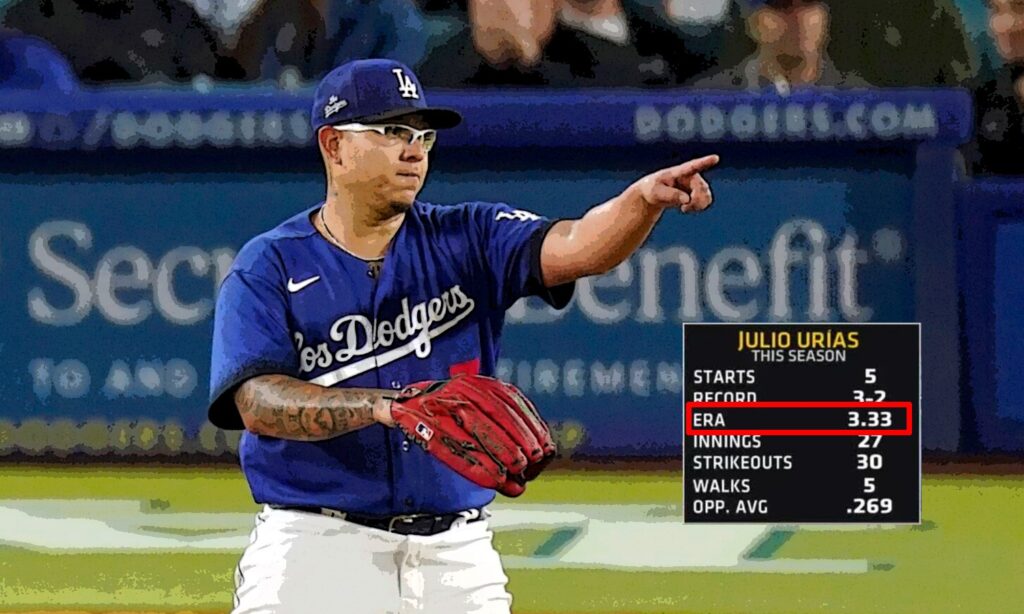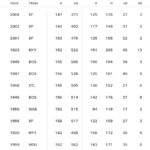The pitcher is the most important position in baseball – bar none.
While some may argue that a good batting lineup, filled with sluggers, will win you games, the pitcher is the leading player on defense.
All plays in baseball start with the pitcher. The ball literally has to be in their hands before each sequence.
Every run, stolen base or out that stem from the fielding team is a consequence of the pitcher.
Which is why pitcher stats are closely monitored by management and displayed on screen for fans to see.
There are many ways to report on a pitcher, but the main components always include their win record, strikeouts, and ERA.
The first two are quite obvious – we want to know how many games they’ve won during the year, especially if they are the starting pitcher.
Furthermore, they’re ability to strikeout the opposing batters regularly is an indication of their pitching dominance and effectiveness.
The ERA is an abbreviated term which relates to the points given up on the scoreboard. But what exactly is it?
What does ERA mean in Baseball?
ERA is an acronym for Earned Run Average and is attributed to pitchers in baseball. The value displayed is the average number of runs a pitcher allows through 9 innings of play. Earned runs are those scored from hits, walks, errors, or other defensive mistakes that can be attributed to the pitcher's performance.
The ERA has been a staple in measuring a pitcher’s effectiveness almost since the start of Major League Baseball.
It was coined by Henry Chadwick who felt that a pitcher’s win-loss record wasn’t always indicative of their gameplay.
The stat further caught on when relief pitchers were more frequently inserted into the game.
If the relief pitcher couldn’t secure the victory, it would affect the starting pitcher’s record despite a having a solid presence.
How is ERA calculated in baseball?
The way to calculate the pitcher’s ERA over a game or the season is quite similar.
First you need to know how many runs they’ve allowed overall.
Then you must determine how many innings they’ve pitched, as it’s likely they did not complete each game.
One stat you must pay particular attention to is the innings played.
For example, if the pitcher completed 6.1 innings of play, it means they pitched six innings and a third.
The decimal point is not an exact fractional value, but rather representative of how many outs they managed in the inning.
Since each inning is made up of three outs, the decimal point can either 0, 1 or 2.
If they played 0.1 or 0.2 innings, it really means they’ve pitched a third or two-thirds of an inning.
That said, let’s calculate the ERA together:
6.1 Innings Pitched
2 Runs Scored
ERA = Runs x 9/Innings Pitched
ERA = 2 x 9/6.333 or 6 and 1/3
ERA = 2.84
What is a good ERA for a pitcher in baseball?
A good ERA for a pitcher sits at the 3.00 mark. Any value below (i.e. 2.00) and your pitcher is having a great season.
Keep in mind that ERA scores can vary from season to season and that starting pitchers see less variance than relievers.
In 2022, Justin Verlander of the Houston Astros was the sole pitcher to manage an ERA below 2.00 with an 18-4 record and 28 games started.
His ERA for the season was at 1.75 and his closest rival was Julio Urias (Los Angeles Dodgers) at 2.16.
Based on Fan Graphs, the average pitcher ERA usually falls at the 3.75 mark.
I’ve included the full chart below to better grade your pitcher’s overall performance.
Pitcher ERA Rating Guide
| Rating | ERA |
|---|---|
| Excellent | 2.50 or less |
| Good | 3.00 |
| Above Average | 3.40 |
| Average | 3.75 |
| Below Average | 4.00 |
| Bad | 4.30 |
| Awful | 4.60 or higher |
Final Thoughts
Just like with the pitcher’s win-loss record, the ERA has its flaws.
There are many elements that can sway a pitcher’s ERA in their favor or negatively over the long term.
The first thing that comes to mind is the overall team strength.
Good pitchers on strong teams tend to perform better than with weaker teams in the league.
One great example was Pedro Martinez who played for my beloved Montreal Expos team in the 1990s.
While he finished his career with an ERA of 2.93, he pitched over a 3.50 ERA for two seasons while at his own peak.
The ERA was also likely affected due to pitching in the NL versus AL due to the designated hitter rule.
As of 2022, the DH was adopted by the National League, meaning that pitchers will no longer face other pitchers at the plate.
The size and location of the ballpark also influence the ERA, as some favored the hitters more than the pitchers.
Think of the stadiums such as Fenway Park (distance of left field wall) and Coors Field (high altitude).
But your best pitchers always find a way.
Remember, the more you strike out your opponents, the less you’ll have to count on external factors to keep your ERA in check.






